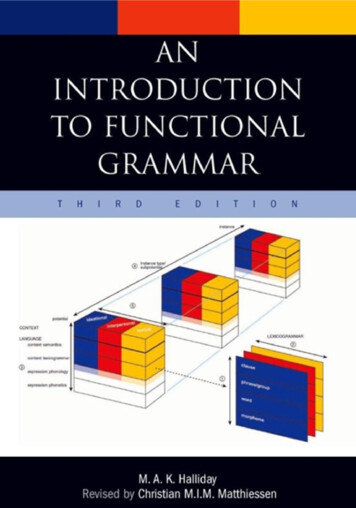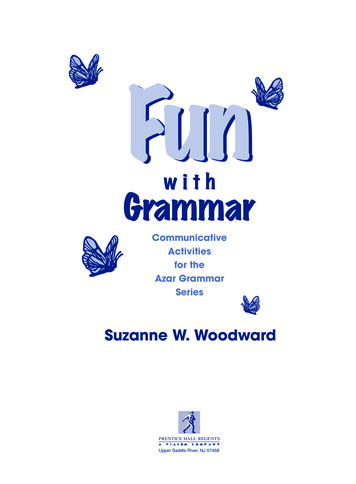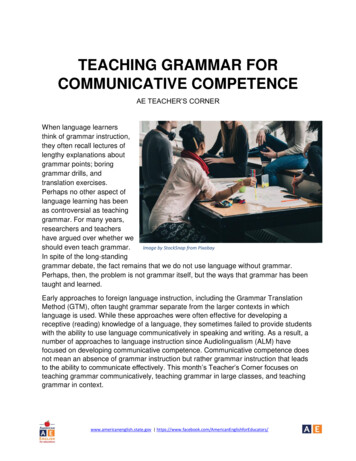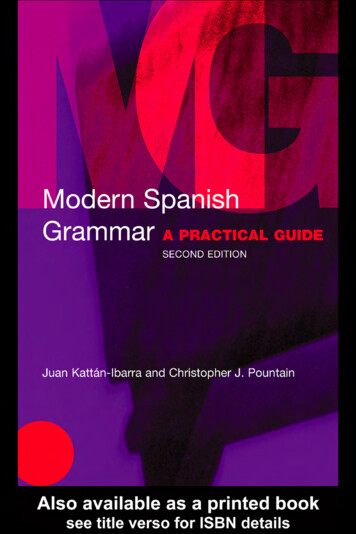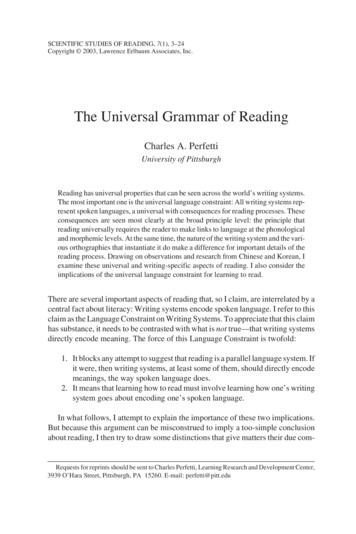
Transcription
SCIENTIFIC STUDIES OF READING, 7(1), 3–24Copyright 2003, Lawrence Erlbaum Associates, Inc.The Universal Grammar of ReadingCharles A. PerfettiUniversity of PittsburghReading has universal properties that can be seen across the world’s writing systems.The most important one is the universal language constraint: All writing systems represent spoken languages, a universal with consequences for reading processes. Theseconsequences are seen most clearly at the broad principle level: the principle thatreading universally requires the reader to make links to language at the phonologicaland morphemic levels. At the same time, the nature of the writing system and the various orthographies that instantiate it do make a difference for important details of thereading process. Drawing on observations and research from Chinese and Korean, Iexamine these universal and writing-specific aspects of reading. I also consider theimplications of the universal language constraint for learning to read.There are several important aspects of reading that, so I claim, are interrelated by acentral fact about literacy: Writing systems encode spoken language. I refer to thisclaim as the Language Constraint on Writing Systems. To appreciate that this claimhas substance, it needs to be contrasted with what is not true—that writing systemsdirectly encode meaning. The force of this Language Constraint is twofold:1. It blocks any attempt to suggest that reading is a parallel language system. Ifit were, then writing systems, at least some of them, should directly encodemeanings, the way spoken language does.2. It means that learning how to read must involve learning how one’s writingsystem goes about encoding one’s spoken language.In what follows, I attempt to explain the importance of these two implications.But because this argument can be misconstrued to imply a too-simple conclusionabout reading, I then try to draw some distinctions that give matters their due com-Requests for reprints should be sent to Charles Perfetti, Learning Research and Development Center,3939 O’Hara Street, Pittsburgh, PA 15260. E-mail: perfetti@pitt.edu
4PERFETTIplexity. I begin by describing possibilities for a Universal Grammar of Reading, anumbrella for a set of proposals that derive from the Language Constraint.A UNIVERSAL GRAMMAR OF READINGTo be sure, Universal Grammar is a rather grand phrasing for the simple idea I havein mind—the universal part is not so much a grammar as a principle—so, I apologize for being grandiose in the hope that grandiosity will be a forgiven feature of aPresidential Address. The basic idea is expressed as follows:(1) Reading : Writing System LanguageProposition 1 asserts that reading is jointly defined by a language and by thewriting system that encodes the language. The language part is to be taken seriously and cannot be identified simply with strings of spoken phonemes.(2) Language Grammar Phonology PragmaticsGrammar Syntax MorphologyMorphology Lexical Roots InflectionsLexical Roots Syntactic Categories MeaningProposition 2 asserts, conventionally with standard linguistic formulations, thatlanguage is an abstract system that includes well-structured subcomponents. Theinterpretation of language tokens—a language’s spoken and written sentences—isjointly determined by these components. The components of the system of mostimportance for reading are phonology and grammar, in particular the morphological subcomponent of grammar. The pragmatic principles that powerfully affectlanguage use are important in reading to an extent that is not completely delineatedand are beyond the scope of my argument. They are not included in the followinganalyses.(3) Writing System Mapping Principles OrthographyMapping Principles Graphic Units Language LevelsOrthography Mapping DetailsThe third proposition is that writing systems can be understood at two levels, ahigher level of mapping principles and a lower level of spelling or orthographicconstraints. The mapping principles are broad enough to include many differentlanguages. The orthographic constraints are definitionally language specific, although they may be very similar across closely related languages.
UNIVERSAL GRAMMAR OF READING5FIGURE 1 Three scripts representing three different writing systems—alphabetic, syllabic,and logographic, from top to bottom. Korean (at top) is alphabetic, with the letters arranged in asquare. Thus a square encodes a syllable of from two to four letters. Japanese Kana (middle) directly represents a spoken syllable. The Chinese character at the bottom represents a word,which happens also to be a syllable.The heart of these ideas is simple: Reading is embedded in two interrelated systems: the Language System and the Writing System. The relation between the firstand the second is variable but persistent. There are no writing systems currently inuse that bypass language to erect an independent system of signs.Writing systems work in three ways, according to most systems of classification (e.g., Gelb, 1952): Alphabetic, Syllabic, and Logographic.1 It is a telling pointthat all three of these systems can be seen in scripts (which are not the same as writing systems) that appear foreign to an eye used to the alphabets that encode European languages, including English. Figure 1 illustrates this point. Presented arethree examples that are visually distinct from those of English and all Europeanand Middle Eastern systems. Furthermore, the three are suggestively similar toeach other, when viewed by an uninformed observer. Indeed, they are more similarto each other in visual form than any of them is to English, Dutch, or Hebrew.In fact, Figure 1 presents not one, but three different writing systems, the entire setthat is traditionally defined by writing scholars. Each graph corresponds to a singlesyllable. The middle row shows the Kana syllabary of Japanese with the logographicChinese at the bottom. But it is the top panel that is especially interesting because itshows an alphabetic system, Korean. The Korean graph contains three letters arrangedfrom left to right, top to bottom. (Other arrangements also occur in Korean.) The lesson for Western eyes is that you can’t tell an alphabet by its ps and qs.1I follow the standard use of logographic to refer to Chinese, the only current example of such a system, only to simplify the argument. In fact, Chinese may be better classified as morphemic (Leong,1973) or, better still, a morphosyllabic system (DeFrancis, 1989), a classification that more directly fixesits linkage to spoken language.
6PERFETTIKorean: An Alphabetic System Plus a MoralThese examples help us realize that the principles of the writing system are distinctfrom the visual appearance of the script. The Korean alphabet (hangul) is especiallyinteresting because of its origins. Korea as well as Japan were prolific borrowers ofthings Chinese, and they made do with borrowed Chinese characters for hundredsof years. The characters were not ideal, however, because the native Korean language is unrelated to Chinese. (The full Korean language contains many Chineseborrowings.) This meant that the characters were mapped with considerable complexity—onto Chinese meanings and sounds, onto Korean meanings and sounds,and onto Korean–Chinese combinations. For example, many characters retainedtheir connection to a Chinese syllable pronunciation that was contained within aKorean word. Others mapped the Chinese meaning of the character onto the Korean equivalent. This complexity led to a less-than-ideal system, although one sufficient to serve an educational elite willing and able to invest the effort to learn it.In the first half of the 15th century, one of the most remarkable of all events inthe history of autocratic governments occurred when King Sejong invented an alphabet for Korean and mandated its universal adoption. The democratic impulsesof this monarch can be seen in this translation of a 1434 edict:Let everyone, in the capital and out, exert themselves in the arts of teaching and instruction let all of them search everywhere for men of learning and sophistication,without regard to whether they are of noble birth or mean, earnestly encouraging themand urging them to teach people to read, even women and girls. (as cited in DeFrancis,1989, p. 189)It is interesting to consider how this egalitarian appeal anticipated a similar onefrom Rudolf Flesch in the United States some 500 years later. In his famous 1955book, Why Johnny Can’t Read, Flesch said, “There is a connection between phonics and democracy—a fundamental connection. Equal opportunity for all is one ofthe inalienable rights, and the word method interferes with that right” (p. 130).Although Rudolf Flesch’s book received a lot of favorable popular press in theUnited States, Flesch was branded as an extremist in the educational establishment, and his arguments had only modest impact on typical reading practice. As amonarch, King Sejong’s exhortations did not suffer this fate. Instead, by the proclamation of 1446, Korea suddenly, without the benefit of writing system evolution,had an alphabet:The sounds of our country’s language are different from those of the Middle Kingdomand are not confluent with the sounds of our characters. Therefore, among the ignorant people, there have been many who, having something they want to put intowords, have in the end been unable to express their feelings. I have been distressed be-
UNIVERSAL GRAMMAR OF READING7cause of this, and have newly designed 28 letters, which I wish to have everyone practice at their ease and make convenient for their daily use. (as cited in DeFrancis, 1989,pp. 189–190)The Korean King and the American Democrat indeed make a compelling combination across the centuries.Is Chinese an Exception to the Universal Grammarof Reading?2Leaving Korean for now, I want to consider the case of Chinese because Chinesehas been taken by some to stand in opposition to the principle that writing systemsencode languages. The popular form of this misconception is that Chinese writingis pictographic, mapping referents and concepts directly. The more sophisticatedform of the misconception is that Chinese, although not mainly pictographic, picksout the meaning level of the language to the exclusion of the phonology. This viewtreats Chinese as a morpheme-based system.The first misconception is easily put to rest by the observation that only about1% or 2% of currently used Chinese characters have identifiable pictographic content (DeFrancis, 1989). Figure 2 illustrates the evolution of the form of the character in the clear direction of abstraction and away from pictures. In Figure 2, it is notpossible to discern a pictured object in either the regular or the simplified character, no matter how pictographic the original appeared in its discovery in Shang dynasty oracle bones (1000 or more BC). Lest anyone suppose that the abstractionwas a recent development, the modern character shown dates to the Han dynasty ofthe early third century.The second belief, that Chinese is morphemic, is not really a misconception butrather an incomplete and, therefore, slightly misleading description. The characters do represent morphemes, but they also represent syllables. Thus, a character ismorphosyllabic, corresponding not to an abstract formless piece of meaning butusually to a spoken Chinese syllable that is also a morpheme. Thus, to reuse thehorse example, the character represents not horsiness but the Chinese single sylla2As real life usually has it, the full story is more complex than the King Sejong story implies. Koreanhas some features that create problems that are absent in most languages that are encoded in an alphabet.In particular, Korean (like Chinese) has much homophony at the syllable level. But the Korean alphabetencodes units of Korean syllables within squares (kulja) that were probably a carryover from the characters, which are also constant shape syllable units. This means a given Korean syllable graph correspondsto more than one Korean morpheme, and the reliable mapping that occurs at the level of orthography tophonology disappears at the meaning level. Modern Korean indeed deviates from consistent spelling–sound mapping allowing less meaning ambiguity.
8PERFETTIFIGURE 2 The rapid loss of pictographic content in Chinese for the character for horse, ma3.The leftmost example is from the Shang dynasty. It is followed by examples from successivepoints in time—from the Great Seal, the Small Seal, and the Scribal. The two rightmost characters are the current regular and simplified characters.ble word ma33 that means horse. This simple fact means that a Chinese charactercan be read to correspond to a meaning, to a spoken word, or both. Because Chinese does not have graphic elements that correspond to phonemes, it is not alphabetic. But the writing unit does correspond to a meaning-bearing spoken languageunit—the syllable. Thus it maps language, as do all writing systems.Beyond this basic fact, Chinese becomes more interesting. The bulk of its characters are not like horse (ma3), which is a simple character not subject to decomposition. Rather, most characters are compounds that combine two or more constituents(components) that can often stand alone as a character to represent a syllable–morpheme. One kind that corresponds to a popular misconception of how Chinese worksin the general case is semantic compounding. For example, the character that meanssun ( , ri4) combines with the character that means moon ( , yue4) to make a compound that can be understood as brightness ( , ming2). Note that there are no sharedpronunciations among these three characters. Although it is intriguing in its potential for semantic productivity, semantic compounding of this kind is actually rare.More common is the kind of phonetic–semantic compounding illustrated inFigures 3 and 4. In these phonetic compounds, one character exposes a clue to itsmeaning and the other (the phonetic) exposes a clue to its pronunciation. In Figure3, notice the first character is again ri4 (sun), but this time it combines with thecharacter for green (qing1), which donates its pronunciation to the compound as awhole. Thus the compound is also pronounced qing2 and means sunshine.What a lovely system Chinese would be if it worked this way generally. Areader could deduce the meaning and the pronunciation of a compound character,provided he or she knew the component pieces. Alas, this is not to be. Althoughmost characters, over 90%, are compounds that contain a potential phonetic component, in most cases the phonetic component does not give a full mapping to thecorrect syllabic pronunciation. Sometimes the component and the character share3The number that follows a syllable represents its tone, one of four pitch contours on Mandarin vowels.
UNIVERSAL GRAMMAR OF READING9FIGURE 3 An example of valid phonetic compounding. The character for ri4 (sun) combineswith the character for qing1 (green). The resulting compound qing2 (sunshine) carries the samepronunciation as one of the components.FIGURE 4 Examples of compounds with invalid phonetics. The first two compounds share aphonetic radical but do not share pronunciation. The bottom compound one shares no components with the first but is identical in pronunciation.a phoneme or two, other times nothing at all. On average, the potential phoneticpart of the compound is more likely to have a pronunciation different from thecharacter as a whole as it is to match it, even disregarding tone.Figure 4 shows an example of this kind of invalid phonetic. Here we see characters that have the same pronunciation, but they do not share a component that provides that pronunciation. So the top and bottom characters are pronounced jing1
10PERFETTIwithout any graphic component that indicates this shared pronunciation. The middle one shares a phonetic with the top one, but its pronunciation is different. So thephonetics in Chinese are not always helpful for pronunciation; in fact, they arehelpful less than half the time.I suppose one might argue that Chinese is about as good as English in this respect—chore and choir share phonetics but not pronunciations. Examples of thevariability of English spelling–pronunciation mappings are stock-in-trade forsome opponents of phonics teaching, as well as the traditional call-to-arms forspelling reformers. The parallel is quite superficial, however, because althoughletters can have variable mappings, the mappings they have are systematic andconstrained. Ch can be /c/ or /k/ but it cannot be something else. Furthermore, themappings in English are increasingly constrained for units larger than the individual letter and are especially reliable at the rime unit (Treiman, Mullennix,Bijeljac-Babic, & Richmond-Welty, 1995).This brings me to another aspect of the Universal Grammar of Reading. Whenthe writing system’s orthography diverges from its phonology, it does so in a waythat is helpful for the reader. In particular, the distribution of this divergence is unequal: The divergence of orthography from pronunciation is less for uncommonwords than it is for common words. This state of affairs is familiar in the case ofEnglish. So-called irregular spellings are more common for high-frequency English words than for low-frequency English words. Chinese shows the same thing.A divergence between the pronunciation of a character and that of its phoneticcomponent is more common for high-frequency characters than for low-frequencycharacters. This relation is shown in Figure 5, where the concept of predictablepronunciation is termed validity, the extent to which the meaning or pronunciationof the character is predictable by one of its components. Thus, validity refers bothto whether the character has the same pronunciation as one of its components andto whether it has a meaning related to the meaning of one of its components. As canbe seen in Figure 5, both phonetic validity and semantic validity increase as frequency decreases (see Perfetti, Zhang, & Berent, 1992).Observing this form–frequency relation in two very different systems suggestsa generalization, or to throw caution to the wind, a universal: Across writing systems, orthographies distribute their divergence from phonology in a way that minimizes the pain to the reader. The particular way this happens has an intriguingparallel with rule-based processes in language. For example, the Englishpast-tense inflection system has both regular (knit, knitted) and irregular (sit, sat)components. But the regular system dominates for low-frequency words, and indeed the introduction of new words, as in foreign borrowings, mandates the use ofthe regular system (Berent, Pinker, & Shimron, 1999). For example, althoughmouse has an irregular plural (mice), if Micky and Minnie Mouse have family, werefer to them collectively as “the Mouses” not “the Mice.” To draw a parallel between the Grammar of Writing Systems and the Grammar of Morphology, it ap-
UNIVERSAL GRAMMAR OF READING11FIGURE 5 The relation between character frequency and validity of semantic and phoneticcomponents. With decreasing character frequency, a character’s components give better clues toboth pronunciation and meaning.pears that it is the default rule of Writing Systems, over their evolutionarydevelopment, to represent pronunciations. Divergence from this rule—an exception—is permitted more freely for frequently experienced forms than for less frequent forms, honoring a kind of orthographic default across writing systems.The Universal Phonological PrincipleBeyond the logic of writing systems, the facts about how they are read also are important. Not only does Chinese embrace the principle that graphic units representpronunciation, the research suggests a use of this pronunciation mapping duringreading for meaning. The research program that my colleagues and I have carriedout comparing Chinese and English has produced ample convergent evidence thatreading for meaning in Chinese automatically involves the activation of phonology. Without going into details here, I can highlight our conclusions, as based ontasks of meaning and pronunciation judgment, word naming, lexical decisions,brief-exposure word identification, and Stroop color naming.For example, in Stroop color naming, we find interference when participants tryto name the color blue when the blue color is contained in the print for the Chineseword for red (Spinks, Liu, Perfetti, & Tan, 2000). This much is standard colorname interference. But the interesting result is what happens when, instead of red(hong2), the word is a homophone of red (hong2), a word referring not to color atall but meaning, roughly, broad. In the interference condition, the color of theink—the color to be named—is blue. The word for red (hong2) should interfere
12PERFETTIwith naming the color blue based on the standard Stroop effect—and it does. Butinterference is also found when the word for broad (hong2) is presented. Noticethis effect is purely one of pronunciation. The two characters for hong2 share nographic elements or any meaning. This interference demonstrates clearly that ignoring a character’s pronunciation is difficult, just as is ignoring its meaning. Theactivation of phonology cannot easily be suppressed, as we have found in othertasks as well (e.g., Perfetti & Zhang, 1995).A typical task from our research is to present readers with pairs of charactersand have them decide whether they are related in meaning and pronunciation. Inthe meaning task, participants viewed one character after another, deciding asquickly as possible whether the two words were related in meaning. On sometrials, the two characters were homophones, sharing neither visual form normeaning but sharing pronunciation. Perfetti and Zhang (1995) found that whenthe two words were homophones unrelated in meaning, participants showed aninterference effect relative to a control condition in which the words were nothomophones. This interference result, well replicated in other studies, meansthat the pronunciation of a character is activated even when the reader’s task isto evaluate its meaning. We have recently obtained some neurocognitive evidence that aligns with what we have found in reaction-time experiments. Wecarried out these experimental tasks while recording event-related potentials(ERPs) from scalp electrodes. At about 250 ms after the onset of the secondcharacter, we found that ERP-measured brain activity was affected by whetherthe word shares pronunciation with the first word. (This homophone effect is apositive-going wave that peaks around 250 ms.) An independent effect of visualsimilarity is observed 50 ms prior to this homophone effect (Liu & Perfetti,2002). Thus, we see ERP evidence for two form effects—one of orthographicform and one of phonological form, in that order. Both of these form effects precede meaning effects observed in these tasks.For the English version of this task, comparative ERP data show some veryinteresting differences from Chinese. The difference is not in phonology somuch as orthography. When American English readers make decisions aboutwhether two words are related in meaning or pronunciation, ERP records show avery early signal associated with similarity of spelling, especially when theirtask is to decide about pronunciation. It is clear that the brain knows how an alphabetic system works. To put it nontechnically, in these two-word decisions,the alphabetic brain is ready for pronunciation similarity when similar spellingsare detected.We are beginning to fill in bits of the picture about how the brain reads Chinese through collaborative research headed by Li Hai Tan (see also Chee, Tan,& Theil, 1999.) These experiments have shown similarities and differences incomparison with English. The most striking similarity is the activation of lefthemisphere frontal regions in meaning tasks, similar to results in English posi-
UNIVERSAL GRAMMAR OF READING13tron emission tomography studies (Fiez & Petersen, 1998). Especially interesting is that such results are obtained for single-character words as well astwo-character words. Previous work on Chinese led to the hypothesis that Chinese single characters were processed nonlinguistically by the right hemisphereand only multiple characters would activate left hemisphere language-processingareas. The results of Tan et al. (2000) demonstrate that even single charactersare linguistic objects as far as the brain is concerned. At the same time, there isevidence across a number of our experiments for activation in some areas notseen in English reading, especially the left–middle frontal gyrus (Brodmann area9), an area that may be associated with spatial and verbal working memory. It ispossible that there is a neural basis for the assumption that Chinese indeed involves a visual–verbal process not seen in linear alphabetic writing and perhapsreflecting spatial analysis of character components (Tan et al., 2000, 2001).However, there still is much to be resolved on this question.If we take a step back to see the big picture over a range of experimental tasks,we come to the clear conclusion that Chinese readers activate phonology evenwhen they read for meaning. However, this does not mean that the writing systemexerts no influence on reading. On the contrary, it is clear that the writing systemmakes a difference in a number of ways, as summarized in Table 1.One difference is that, although Chinese and English reading both involve automatic activation of phonological forms, English, as an alphabetic system, allows this to occur sublexically in what can be termed cascade style. That is, theactivation of phonemes based on graphemes accumulates rapidly, cascading toword identification. The activation of a higher unit does not await complete processing of a lower unit but begins immediately even as some graphemes are onlypartly processed.In Chinese, the process is different. The activation of phonology awaits athreshold level of graphic recognition before firing. Sublexical phonology (basedon a character’s phonetic component) can be observed under conditions that require pronunciation. However, when meaning is the reader’s task, the evidencesuggests that the phonology is activated in this graphic-threshold style—the proTABLE 1Some Comparisons Between English and ChineseAlphabetic (English)1. Phonology activated with orthography—threshold style2. Sublexical units: proper parts3. Phonology can be “pre-lexical”4. Phonology can “mediate” meaning—but phonological coherence more aptLogographic (Chinese)1. Phonology activated with orthography—threshold style2. Sublexical units: wholes are parts3. “Pre-lexical” is not a coherent concept4. “Mediation” is a dubious concept—phonological diffusion more apt
14PERFETTInunciation of the character as a whole (Zhang, Perfetti, & Yang, 1999). A second,related point is that the phonology of English can be prelexical in that thegrapheme–phoneme connections drive phonology from the first moments of visual word processing (Perfetti & Bell, 1991). Chinese does not have prelexicalphonology. The phonology that corresponds to a component is syllable-size andmorphemic (i.e., the component is also a word). Thus its effect can be considerednot prelexical but lexical. In Chinese the part is also a whole.Another distinction to note is that phonological mediation becomes an awkward concept in Chinese, a fact that follows from the differences I just noted. Infact, the pervasive number of homophones in Chinese—on average, 11 characters share a given syllable/morpheme—makes phonological mediation not veryhelpful. A pronunciation will nearly always be ambiguous in Chinese. We actually have found mediation effects when the number of homophones for a character is small (Tan & Perfetti, 1997). But the more general point is that phonologyprovides some constraint on identification, a way of talking that will apply aswell to English as to Chinese. Indeed, I think the idea of phonological mediation, as it has been traditionally understood, needs to be abandoned and replaced, as Van Orden and Goldinger (1994) also suggested, by a process thatbrings about a convergence of identification based on orthographic, phonological, and morphemic constraints.The fully detailed picture is beyond the scope of this article, so I repeat themain points: The first is that there is no writing system that is read without phonology. Chinese is not an exception to the universal scope of phonology in reading. The second is that the writing system does make a difference. In phonology,the difference it makes is in the details of the orthography-to-phonologymappings. These details are important for the process of reading and for learningto read. There are other differences involving other aspects of the language system—morphology especially, but also syntax—that must be taken into accountfor a detailed comparison.The idea of the Language Constraint on reading entails a research program thatseeks to understand languages and writing systems to discover the universal principles and also the linguistic and writing system details that control reading.Studies of Korean that we (D. J. Bolger and I) have undertaken with Dr. HyeKyung Yoon illustrate this idea (Yoon, Bolger, Kwon, & Perfetti, 1999). Thesestudies suggest that, although English readers are highly sensitive to rime units inlearning to read and in some reading tasks, Korean readers are not. Instead, Koreanreaders are sensitive to the syllable body (onset plus vowel). Thus, for an Englishreader, the structure of the word sheep as sh eep (onset plus rime) is functional inlearning and in some tasks of skilled reading (but not all; see Booth & Perfetti,2002). For the Korean reader, the preferred structure is shee p (body coda)
What a lovely system Chinese would be if it worked this way generally. A reader could deduce the meaning and the pronunciation of a compound character, provided he or she knew the component pieces. Alas, this is not to be. Although most characters, over 90%, are compounds that contain a potential phonetic com-



